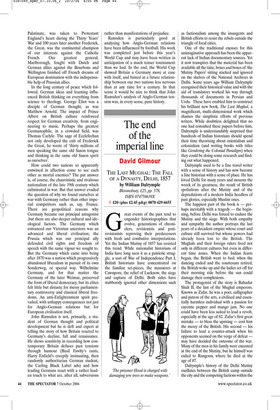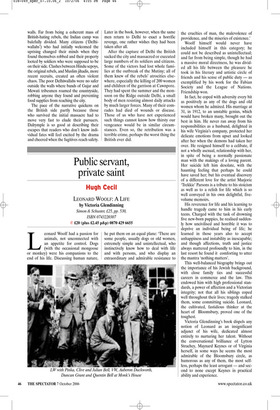The end of the imperial line
David Gilmour
THE LAST MUGHAL: THE FALL OF A DYNASTY, DELHI, 1857 by William Dalrymple Bloomsbury, £25, pp. 578, ISBN 074758639X ✆ £20 (plus £2.45 p&p) 0870 429 6655 Great events of the past tend to engender historiographies that evolve, generations of chroniclers, revisionists and postrevisionists reproving their predecessors with fresh and combative interpretations. Yet the Indian Mutiny of 1857 has resisted this trend. While nationalist historians of India have long seen it as a patriotic struggle, a sort of War of Independence Part I, British historians have concentrated on the familiar set-pieces, the massacres at Cawnpore, the relief of Lucknow, the siege and capture of Delhi. Both sides have stubbornly ignored other dimensions such as factionalism among the insurgents and British efforts to resist the rebels outside the triangle of focal cities.
One of the traditional excuses for this unimaginative approach has been the apparent lack of Indian documentary sources. Yet it now transpires that the material has been available all the time, boxes and boxes of ‘the Mutiny Papers’ sitting stacked and ignored on the shelves of the National Archives in Delhi. Some years ago William Dalrymple recognised their historical value and with the aid of translators worked his way through thousands of documents in Persian and Urdu. These have enabled him to construct his brilliant new book, The Last Mughal, a magnificent, multi-dimensional work which shames the simplistic efforts of previous writers. While doubtless delighted that no one had consulted these papers before him, Dalrymple is understandably surprised that hundreds of Indian historians should spend their time theorising about orientalism and colonialism (and writing books with titles like Gendering the Colonial Paradigm) when they could be doing some research and finding out what happened.
Dalrymple used to be a fine travel writer with a sense of history and has now become a fine historian with a sense of place. He has loved Delhi for many years and mourns the wreck of its greatness, the result of British spoliations after the Mutiny and of the depredations of a modern India heedless of past glories, especially Muslim ones.
The happiest part of the book is — perhaps inevitably with a tragedy — the beginning, before Delhi was forced to endure the Mutiny and the siege. With both empathy and sympathy the author portrays the last years of a decadent empire whose court and culture still survived but whose powers had already been lost to the British. The Mughals and their foreign rulers lived not only in different cultures but even in different time zones. When the Indian feasts began, the British went to bed; when the dancing ended and the courtesans retired, the British woke up and the ladies set off for their morning ride before the sun could damage their complexions.
The protagonist of the story is Bahadur Shah II, the last of the Mughal emperors. Known as Zafar, he was a poet, calligrapher and patron of the arts, a civilised and essentially harmless individual with a passion for cayenne pepper and mango jam. No one could have been less suited to lead a revolt, especially at the age of 82. Zafar’s first great mistake — to bless the uprising — cost him the mercy of the British. His second — his failure to lead a counter-attack when his opponents seemed on the verge of defeat may have decided the outcome of the war. Many of the men in his family were executed at the end of the Mutiny, but he himself was exiled to Rangoon, where he died at the age of 87.
Dalrymple’s history of the Delhi Mutiny oscillates between the British camp outside the city and the competing factions within the walls. Far from being a coherent mass of British-hating rebels, the Indian camp was balefully divided. Many citizens (‘Delhiwallahs’) who had initially welcomed the uprising changed their minds when they found themselves robbed and their property looted by soldiers who were supposed to be on their side. Clashes between Hindu sepoys, the original rebels, and Muslim jihadis, more recent recruits, created an often violent chaos. The poor Delhiwallahs were no safer outside the walls where bands of Gujar and Mewati tribesmen roamed the countryside, robbing anyone they found and preventing food supplies from reaching the city.
The pace of the narrative quickens on the British side partly because those who survived the initial massacre had to move very fast to elude their pursuers. Dalrymple is so good at describing their escapes that readers who don’t know individual fates will feel excited by the drama and cheered when the fugitives reach safety. Later in the book, however, when the same men return to Delhi to exact a horrific revenge, one rather wishes they had been taken after all.
After the capture of Delhi the British sacked the city and massacred or executed large numbers of its soldiers and citizens. Some of the victors had lost whole families at the outbreak of the Mutiny; all of them knew of the rebels’ atrocities elsewhere, especially the killing of 200 women and children of the garrison at Cawnpore. They had spent the summer and the monsoon on the Ridge outside Delhi, a small body of men resisting almost daily attacks by much larger forces. Many of their comrades had died of wounds or disease. Those of us who have not experienced such things cannot know how thirsty our vengeance would be in similar circumstances. Even so, the retribution was a terrible crime, perhaps the worst thing the British ever did. the cruelties of man, the malevolence of providence, and the miseries of existence.’ Woolf himself would never have included himself in this category; he could not be described as unintellectual; and far from being simple, though he had a massive moral directness, he was divided all his life between the pleasure he took in his literary and artistic circle of friends and his sense of public duty — as exemplified by his work for the Fabian Society and the League of Nations. Friendship won.
In fact, he coped with adversity every bit as positively as any of the dogs and old women whom he admired. His marriage at 31, in 1912, to an unstable genius, which would have broken many, brought out the best in him. He never ran away from his responsibilities as a husband, delighted in his wife Virginia’s company, protected her delicate emotions from upset and looked after her when the demons had taken her over. He resigned himself to a celibate, if not a wholly asexual, relationship with her, in spite of being a normally passionate man with the makings of a loving parent. Her suicide left him desolate, with the haunting feeling that perhaps he could have saved her; but his eventual discovery of a different love for the artist Marjorie ‘Trekkie’ Parsons is a tribute to his stoicism as well as to a relish for life which is so well conveyed in his own delightful, fivevolume memoirs.
His reverence for life and his learning to handle tragedy came to him in his early teens. Charged with the task of drowning five new-born puppies, he realised suddenly how uncivilised and horrible it was to deprive an individual being of life; he learned in those years also to accept unhappiness and instability as inescapable; and though affections, truth and justice always mattered profoundly to him, in the last resort he found it comforting to utter the mantra ‘nothing matters’.
This well-balanced biography brings out the importance of his Jewish background, with close family ties and successful careers in commerce and the law. This endowed him with high professional standards, a power of affection and a Victorian integrity; not that all his siblings coped well throughout their lives; tragedy stalked them, some committing suicide. Leonard, the cultivated, fastidious thinker at the heart of Bloomsbury, proved one of the toughest.
Victoria Glendinning’s book dispels any notion of Leonard as an insignificant adjunct of his wife, dedicated almost entirely to nurturing her talent. Without the conversational brilliance of Lytton Strachey, Maynard Keynes or of Virginia herself, in some ways he seems the most admirable of the Bloomsbury circle, as humorous as any of them, the most selfless, perhaps the least arrogant — and second to none except Keynes in practical ability and experience.



















































































 Previous page
Previous page